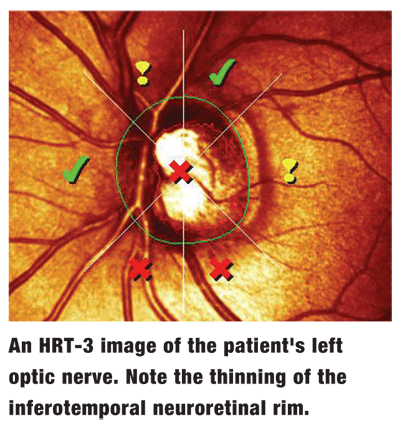 In 2004, a 55-year-old white male presented as a new patient after recently relocating to the area from
In 2004, a 55-year-old white male presented as a new patient after recently relocating to the area from
The patient said he saw his previous eye doctor at six-month intervals, and that his IOP typically measured between 18mm Hg and 23mm Hg O.U. He took no other medications and reported being in excellent health.
Diagnostic Data
At the patients initial visit in 2004, his best-corrected visual acuity was 20/20 O.U. through minimal spherical myopic and presbyopic correction. His pupils were equally round and reactive to light and accommodation, with no afferent pupillary defect.
Extraocular motilities were full in all positions of gaze. Slit lamp examination of the anterior segment was unremarkable O.U.
IOP measured 23mm Hg O.U. Gonioscopy demonstrated grade 2 to grade 3 open angles O.U., with patent peripheral iridotomies O.U., minimal pigment and normal anatomy. There was a trace of pseudoexfoliative material in the right anterior chamber angle.
 Through dilated pupils, his crystalline lenses were clear O.U. Cup-to-disc ratio was 0.60 x 0.60 O.U., and there was thinning of the inferior neuroretinal rim O.U.
Through dilated pupils, his crystalline lenses were clear O.U. Cup-to-disc ratio was 0.60 x 0.60 O.U., and there was thinning of the inferior neuroretinal rim O.U.
Neuroretinal rim characteristics did not follow the ISNT (inferior-superior-nasal-temporal) rule. His retinal vasculature was normal, and spontaneous venous pulsations were present bilaterally. His macular and peripheral retinal exams were also unremarkable.
I diagnosed the patient with pseudoexfoliative glaucoma and did not make any changes to his medications. I asked him to return in three months for visual field testing, optic nerve imaging and repeat IOP measurement.
The patient presented again in three months, but his records were still unavailable. At this visit, IOP measured 16mm Hg O.D. and 18mm Hg O.S. Threshold visual fields demonstrated no field loss O.U., and reliability indices were high. Optic nerve evaluation remained unchanged O.U. Again, I asked him to return in another three months.
We finally located and reviewed the patients old records before this visit. He was initially diagnosed with narrow angle glaucoma, which subsequently progressed to partial angle-closure glaucoma with increased IOP; this prompted a bilateral laser peripheral iridotomy (LPI) procedure. Since he underwent the LPIs, IOP has ranged from 18mm Hg to 23mm Hg O.U., as the patient initially reported. There was no mention of pseudoexfoliation in the previous records.
Even though the patients glaucoma remained stable over the previous two years, I suggested that he switch from a medication dosed t.i.d. to one administered only once per day. The patient agreed, and I switched him to Lumigan (bimatoprost, Allergan) q.h.s. O.U.
Discussion
While there was no guarantee that the switch to once-daily Lumigan would offer the same stability as Alphagan t.i.d., the dosing change simplified the patients medication regimen.
Even with the adjustment to a q.h.s. medication, his optic nerves and visual fields have remained stable, and his IOP has ranged from 14mm Hg to 22mm Hg O.D. and 17mm Hg to 22mm Hg O.S.
While the medical management of this patient is fairly straightforward, this situation presents two issues that we need to address when treating glaucoma patients.
The first pertains to managing new patients who present with a previous diagnosis of glaucoma. In this particular case, another doctor treated the patients glaucoma for three years before he came to see me upon moving to
Questioning the dosing decision of a previous eye-care provider could make a new patient nervous or anxious. So, I elected to examine the patient two more times without changing his medication, got to know him and eventually suggested the possibility of changing to a q.h.s. medication. He personally chose to change to q.h.s. monotherapy.
When the patient was seen most recently in August 2008, there was no discernable change to his optic nerve structure or visual function since initial presentation.
The second patient management issue associated with this case is the challenge of facilitating compliance. Because this patient was compliant with a t.i.d. dosing schedule that effectively kept his glaucoma stable, I could have simply kept the patient on his existing regimen and not suggested the change to Lumigan q.h.s.
However, compliance with medication regimens is often a tremendous problem when treating patients with chronic illnesses, such as glaucoma.
Several factors play a role in facilitating compliance. These include the doctor/patient relationship, the number and intensity of side effects associated with the medication, and the cost of the medication. However, one of the most important factors concerning patient compliance is the ease of medication delivery.
Naturally, most patients prefer once-a-day dosing vs. multiple doses throughout the day. The patient can more easily remember to administer only one dose of a medication per day. Also, this regimen generally promotes better consistency, and, in turn, a more effective treatment.
When managing glaucoma patients, there are no guarantees that therapy will remain effective over the long term, that the patient will be compliant, or that the patient will not eventually go blind. But, we can reduce the likelihood of these problems by providing the best care possible.
This starts with the establishment of a solid doctor/patient relationship. With that relationship in place, promoting patient compliance is significantly easier.

